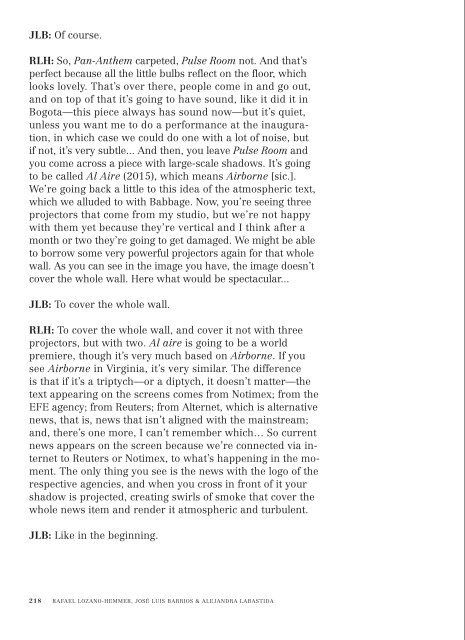Create successful ePaper yourself
Turn your PDF publications into a flip-book with our unique Google optimized e-Paper software.
JLB: Of course.<br />
RLH: So, Pan-Anthem carpeted, Pulse Room not. And that’s<br />
perfect because all the little bulbs reflect on the floor, which<br />
looks lovely. That’s over there, people come in and go out,<br />
and on top of that it’s going to have sound, like it did it in<br />
Bogota—this piece always has sound now—but it’s quiet,<br />
unless you want me to do a performance at the inauguration,<br />
in which case we could do one with a lot of noise, but<br />
if not, it’s very subtle... And then, you leave Pulse Room and<br />
you come across a piece with large-scale shadows. It’s going<br />
to be called Al Aire (2015), which means Airborne [sic.].<br />
We’re going back a little to this idea of the atmospheric text,<br />
which we alluded to with Babbage. Now, you’re seeing three<br />
projectors that come from my studio, but we’re not happy<br />
with them yet because they’re vertical and I think after a<br />
month or two they’re going to get damaged. We might be able<br />
to borrow some very powerful projectors again for that whole<br />
wall. As you can see in the image you have, the image doesn’t<br />
cover the whole wall. Here what would be spectacular...<br />
JLB: To cover the whole wall.<br />
RLH: To cover the whole wall, and cover it not with three<br />
projectors, but with two. Al aire is going to be a world<br />
premiere, though it’s very much based on Airborne. If you<br />
see Airborne in Virginia, it’s very similar. The difference<br />
is that if it’s a triptych—or a diptych, it doesn’t matter—the<br />
text appearing on the screens comes from Notimex; from the<br />
EFE agency; from Reuters; from Alternet, which is alternative<br />
news, that is, news that isn’t aligned with the mainstream;<br />
and, there’s one more, I can’t remember which… So current<br />
news appears on the screen because we’re connected via internet<br />
to Reuters or Notimex, to what’s happening in the moment.<br />
The only thing you see is the news with the logo of the<br />
respective agencies, and when you cross in front of it your<br />
shadow is projected, creating swirls of smoke that cover the<br />
whole news item and render it atmospheric and turbulent.<br />
JLB: Like in the beginning.<br />
RLH: Like in the beginning or like… Do you remember the<br />
piece in the Laboratorio Alameda, the projection of shadows in<br />
the hall? It’s like that but with text instead of particles of smoke.<br />
JLB: How beautiful.<br />
RLH: Finally, you go into Zoom Pavilion (2015), a series of<br />
twelve projectors that the MUAC already has and that project<br />
a mosaic on three walls, with four projections on each<br />
one. When you go in there are twelve industrial cameras<br />
and the only thing you see is the raw image from the twelve<br />
cameras—but huge, and, as you enter, the systems of facial<br />
recognition detect your face and zoom in. Your face is then<br />
projected on an architectural scale. Then, if someone else<br />
suddenly enters, what the camera does is zoom out so that<br />
your face and his or hers are included in the same photogram.<br />
The transformation of these two screens is constantly<br />
zooming in and zooming out on the facial features of the<br />
people passing in front, and what’s interesting about this is<br />
that we’re not conducting a surveillance of the subject here<br />
—which is always the case—but here it’s a surveillance of<br />
relationship, of the meeting, because the cameras don’t just<br />
zoom in on your face but on the relationship of your face<br />
with others.<br />
JLB: On any face.<br />
RLH: Yes, in effect: if you two are there and are sharing the<br />
experience, your faces will appear in the same square. And if<br />
you move closer to each other, the camera zooms in to include<br />
both your faces. The result is that if someone comes with<br />
their husband or wife or whoever, and they’re very close or<br />
embracing, their image is amplified extraordinarily. If, on<br />
the other hand, you come alone and you’re walking, your<br />
face will appear in relation to that of the other people walking<br />
in that area. It’s a very vertiginous and fun piece, but at<br />
the same time a terrifying one, because it’s the surveillance<br />
of relationship.<br />
JLB: It goes against freedom of association.<br />
218 RAFAEL LOZANO-HEMMER, JOSÉ LUIS BARRIOS & ALEJANDRA LABASTIDA<br />
CONVERSATION ON THE LAYOUT OF THE EXHIBITION 219


